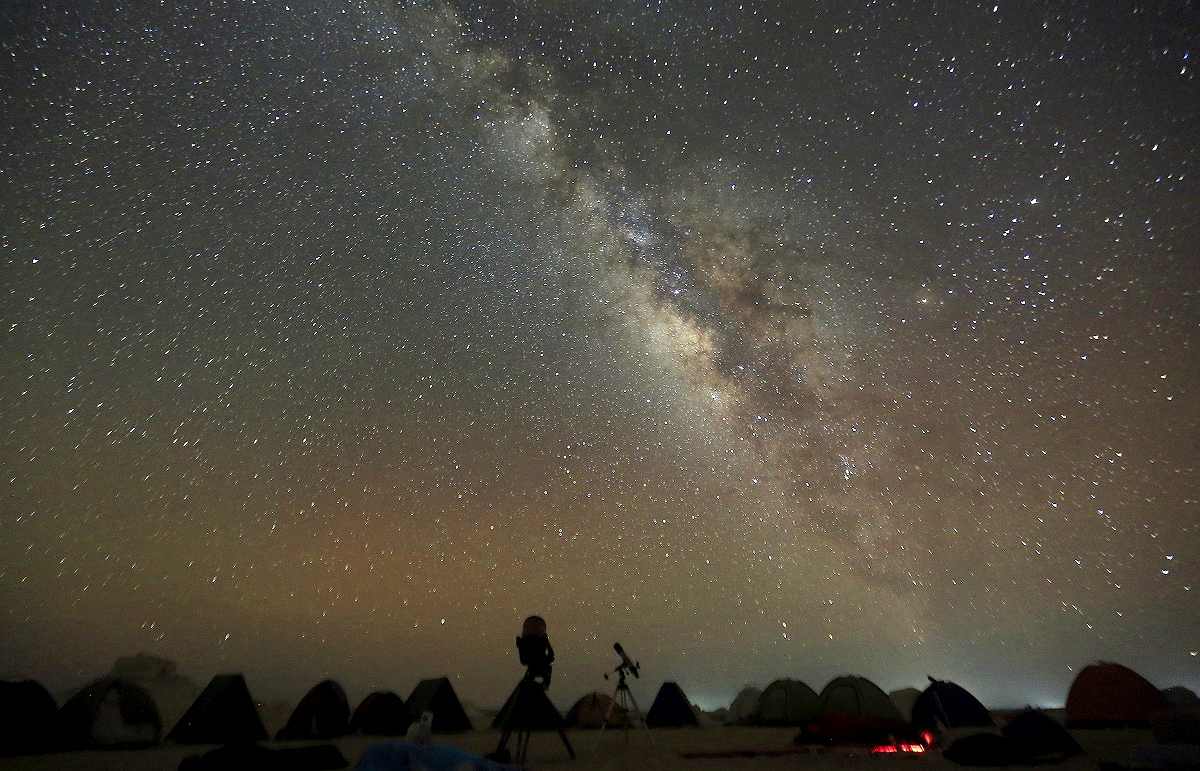
The Milky Way is seen above telescopes and camps of people in the White Desert north of the Farafra Oasis, Egypt, in May 2015.
12:51 JST, February 1, 2023
WASHINGTON (Reuters) — Astronomers have detected in the stellar halo that represents the Milky Way’s outer limits a group of stars more distant from Earth than any known within our own galaxy — almost halfway to a neighboring galaxy.
The researchers said these 208 stars inhabit the most remote reaches of the Milky Way’s halo, a spherical stellar cloud dominated by the mysterious invisible substance called dark matter that makes itself known only through its gravitational influence. The furthest of them is 1.08 million light years from Earth. A light year is the distance light travels in a year, 9.5 trillion kilometers.
These stars, spotted using the Canada-France-Hawaii Telescope on Hawaii’s Mauna Kea mountain, are part of a category of stars called RR Lyrae that are relatively low mass and typically have low abundances of elements heavier than hydrogen and helium. The most distant one appears to have a mass about 70% that of our sun. No other Milky Way stars have been confidently measured farther away than these.
The stars that populate the outskirts of the galactic halo can be viewed as stellar orphans, probably originating in smaller galaxies that later collided with the larger Milky Way.
“Our interpretation about the origin of these distant stars is that they are most likely born in the halos of dwarf galaxies and star clusters which were later merged — or more straightforwardly, cannibalized — by the Milky Way,” said Yuting Feng, an astronomy doctoral student at the University of California, Santa Cruz, who led the study, presented last month at an American Astronomical Society meeting in Seattle.
“Their host galaxies have been gravitationally shredded and digested, but these stars are left at that large distance as debris of the merger event,” Feng added.
The Milky Way has grown over time through such calamities.
“The larger galaxy grows by eating smaller galaxies — by eating its own kind,” said study coauthor Raja GuhaThakurta, UC Santa Cruz’s chair of astronomy and astrophysics.
Containing an inner and outer layer, the Milky Way’s halo is vastly larger than the galaxy’s main disk and central bulge that are teeming with stars. The galaxy, with a supermassive black hole at its center about 26,000 light years from Earth, contains perhaps 100 billion to 400 billion stars including our sun, which resides in one of the four primary spiral arms that make up the Milky Way’s disk. The halo contains about 5% of the galaxy’s stars.
Dark matter, which dominates the halo, makes up most of the universe’s mass and is thought to be responsible for its basic structure, with its gravity influencing visible matter to come together and form stars and galaxies.
The halo’s remote outer edge is a poorly understood region of the galaxy. These newly identified stars are almost half the distance to the Milky Way’s neighboring Andromeda galaxy.
“We can see that the suburbs of the Andromeda halo and the Milky Way halo are really extended — and are almost ‘back-to-back,’” Feng said.
The search for life beyond the Earth focuses on rocky planets akin to Earth orbiting in what is called the “habitable zone” around stars. More than 5,000 planets beyond our solar system, called exoplanets, already have been discovered.
"Science & Nature" POPULAR ARTICLE
-

Genome Study Reveals Milestone in History of Cat Domestication
-

Big Leap in Quest to Get to Bottom of Climate Ice Mystery
-

Security Camera Footage Vulnerable to Outside Access; Investigation Finds 3,000 Pieces Exposed Online
-

Paws on Parade: Nairobi’s Dogs Dazzle at ‘Pawchella’
-

Japan Set to Participate in EU’s R&D Framework, Aims to Boost Cooperation in Tech, Energy
JN ACCESS RANKING
-

Keidanren Chairman Yoshinobu Tsutsui Visits Kashiwazaki-Kariwa Nuclear Power Plant; Inspects New Emergency Safety System
-

Tokyo Economic Security Forum to Hold Inaugural Meeting Amid Tense Global Environment
-

Imports of Rare Earths from China Facing Delays, May Be Caused by Deterioration of Japan-China Relations
-

University of Tokyo Professor Discusses Japanese Economic Security in Interview Ahead of Forum
-

Japan Pulls out of Vietnam Nuclear Project, Complicating Hanoi’s Power Plans






















